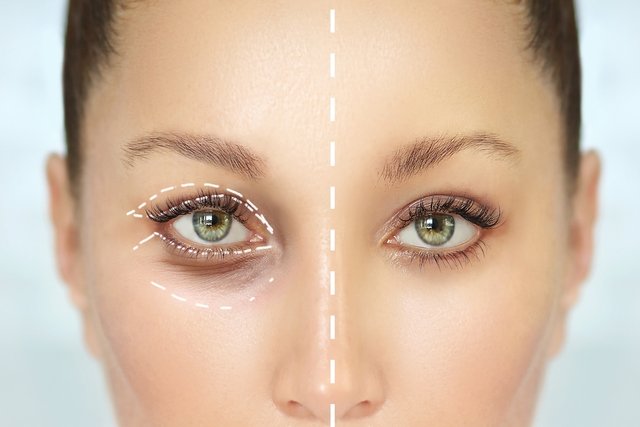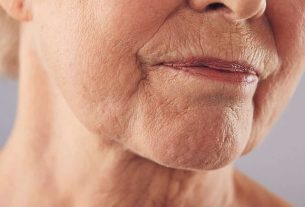Blepharoplasty is a plastic surgery indicated to remove excess skin or fat from the eyelids, in addition to repositioning them correctly, reducing a tired and aged appearance.
This surgery can be performed only on the upper or lower eyelid, or both, and in some cases botox can be applied together with blepharoplasty to improve aesthetic results or perform a lifting facial making the face younger and more beautiful. See how botox is done.
Blepharoplasty is performed by an ocular plastic surgeon in the hospital, without the need for hospitalization, and the results can be seen 15 days after surgery, however, the definitive result can only be seen after 3 months.

When is indicated
Blepharoplasty is indicated for:
- Drooping upper eyelids;
- Partial blockage of peripheral vision due to excess skin on the upper eyelids;
- Bags under the eyes;
- Excess skin or fat on the lower or upper eyelids;
- Flaccidity of the skin or muscles of the upper eyelids;
- Lower eyelid turned outwards, as if it had drooped, called palpebral ectropion.
This surgery allows you to remove excess skin or fat from the upper or lower eyelids or reposition fat deposits, and is normally recommended after the age of 40, due to the appearance of signs of aging as a result of the loss of skin elasticity.
Despite being performed more frequently on older people with signs of aging, blepharoplasty can also be performed on younger people when the problem is related to genetic factors.
How to prepare for blepharoplasty
To prepare for blepharoplasty, some precautions are important, such as clarifying all doubts about the surgery, recovery and expectations with the surgeon, as well as not smoking at least 2 weeks before surgery and avoiding sun exposure.
In addition, you must inform all medications, vitamins and nutritional supplements that you frequently take, and if you have any allergies or other health problems. In some cases, your doctor may recommend stopping anticoagulant treatment a few days before surgery to prevent bleeding.
It is also recommended to avoid drinking alcoholic beverages at least the day before surgery and to fast for at least 8 hours before surgery, as per medical advice.
Before undergoing blepharoplasty, you must also undergo all the tests requested by your doctor to assess your general health and the risk of complications.
If you want to have blepharoplasty, make an appointment with a plastic surgeon in the nearest region:
Taking care of your health has never been easier!
How it is made
Blepharoplasty must be performed by a plastic surgeon or ophthalmologist specializing in ocular plastic surgery, as it is essential that the integrity of the health of the eyes is maintained throughout the procedure.
To perform the surgery, the doctor must follow some steps, which are:
- Define the location where the surgery will be performedwhich can be on the upper, lower eyelid or both;
- Make cuts in the delimited areas and remove excess skinfat and muscle and sews the skin together, this procedure being known as classic blepharoplasty;
- Close the cuts and apply steri-strips about the suturewhich are points that stick to the skin and do not cause pain.
The classic blepharoplasty scar is simple and thin, easily hidden in skin folds or under the eyelashes, without being visible.
This cosmetic surgery lasts an average of 40 minutes to 1 hour and is normally performed under local anesthesia, however, some people prefer it to be performed under general anesthesia.
After the procedure, the person may stay in the hospital for a few hours until the anesthesia wears off, and then be released home with some recommendations that must be followed.
Transconjunctival blepharoplasty
In the case of younger people, where there is no excess skin, transconjunctival surgery can be performed, in which a cut is made in the conjunctiva of the lower eyelid, in a way that does not leave a visible scar, to remove excess fat in the area. .
In the case of excess skin, classic blepharoplasty is recommended.
What is the post-operative period like?
Post-operatively after blepharoplasty, it is common for people to have a swollen face, purple spots and small bruises, which generally disappear 8 days after surgery.
In addition, it is possible for there to be intense itching, swelling of the eyelid and a round eye, which occurs if excess skin is removed from the lower eyelid.
Although rare, there may be blurred vision and sensitivity to light in the first 2 days. Serious complications are very rare in this type of surgery and scars are usually imperceptible.
What is recovery like?
Recovery from blepharoplasty takes on average around 2 weeks and during this period it is recommended:
- Place cold compresses on the eyes to reduce swelling;
- Use eye drops or ophthalmological ointments or oral analgesics, as advised by the doctor;
- Sleep on your back with a pillow over your neck and torso, keeping your head higher than your body;
- Wear sunglasses when leaving home to protect from sunlight;
- Do not wear eye makeup and do not swim, carry weight or do aerobic exercises;
- Do not wear contact lenses and do not smoke;
- Always use sunscreen to prevent scars from getting darker.
This care must be maintained for up to 15 days after surgery, but the person must return to the doctor for a review appointment and the stitches to be removed.
To speed up recovery and so that the person can return to their daily activities faster, it is recommended to undergo dermato-functional physiotherapy to combat swelling and remove bruises, as long as indicated by the doctor.
Possible complications
The main complications of blepharoplasty are infections or bleeding at the surgical site, dry eye, or discoloration of the eyelids.
In addition, there may also be scarring at the site, difficulty closing the eyes completely or even loss of vision.

Sign up for our newsletter and stay up to date with exclusive news
that can transform your routine!
Warning: Undefined array key "title" in /home/storelat/public_html/wp-content/plugins/link-whisper-premium/templates/frontend/related-posts.php on line 12
Warning: Undefined array key "title_tag" in /home/storelat/public_html/wp-content/plugins/link-whisper-premium/templates/frontend/related-posts.php on line 13



